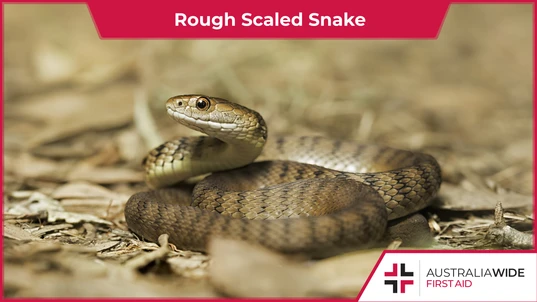All About the Rough Scaled Snake

Bites and Stings

The Rough scaled snake is a highly venomous member of the Elapidae snake family and is located along parts of Australia's eastern coast. They have been responsible for at least one human fatality.
There are roughly 77 Australian elapid snake species - terrestrial snakes that have a sophisticated venom delivery system and fixed fangs in the front of their upper jaw. The Rough scaled snake is one such example. As well as being dangerously venomous, these snakes have the unique ability to climb, hunt, and shelter in trees and low vegetation. It is important to be wary of the Rough scaled snake. Though they are shy and generally found in undisturbed habitat, their neurotoxic venom has been responsible for at least one human fatality. In this article, we will help you become more familiar with the Rough scaled snake's behaviour and identifying characteristics, and what to do if you are bitten by one. You can also enrol in our First Aid and Child Care First Aid courses to learn about the practicalities of treating different snake bites.Identifying characteristics
The Rough scaled snake (Tropidechis carinatus) generally has the following characteristics:- Slender to medium build
- Average length of 75cm to 1m
- Olive brown to dark brown scales on its top and sides, traversed with darker stripes or blotches
- The body scales are strongly keeled (have a ridge down the centre) and matte in appearance
- The underbelly generally ranges from greenish-grey to olive-cream in colour
- They have a large head that is glossy, lacks patterns, and is slightly darker than the rest of their body
Habitat
The Rough scaled snake prefers moist habitats, such as:- Rainforest
- Wet sclerophyll forest
- Heathland
Habits
The Rough scaled snake is active during the day and at night, when they prey on and ambush a variety of vertebrates, including mammals, lizards, and frogs. Though they generally forage on the ground, they have been known to climb to heights of at least 5m to hunt and take shelter. Additionally, females give birth to live young, usually in the late summer.Danger to humans
Like the Australian eastern brown and similar species, the Rough scaled snake is shy, nervous, and will readily bite if cornered. Their venom is highly toxic and can destroy nerve cells, red blood cells, and other living cells. Their bites have been responsible for at least one human fatality, and several other severe cases of envenomation.
A bite from a Rough scaled snake should be treated as a medical emergency. Follow DRSABCD, call Triple Zero (000) for an ambulance, and apply the Pressure Immobilisation Technique (pictured above) to slow the venom's spread through the body.
First aid
If bitten by a Rough scaled snake, you should follow DRSABCD, call Triple Zero (000) for an ambulance, and apply the Pressure Immobilisation Technique. More information can be found in our article on identifying and treating bites from some of Australia's deadliest snake species.Final thoughts
If you would like to learn more about treating a bite from a Rough scaled snake, a brown to olive coloured snake found across parts of the Australian east coast, book a First Aid or Child Care First Aid course at a location near you today.
Originally published at
https://www.australiawidefirstaid.com.au/resources/rough-scaled-snake
as part of the Australia Wide First Aid Articles Library









